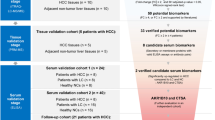Abstract
Background
Prohibitin (PHB) was found to be overexpressed in breast cancer and thus is suggested as a biomarker in that disease. A few studies have investigated the PHB expression pattern in gastric cancer by two-dimensional gel electrophoresis. Uncertainties still existed on whether PHB expression could indicate the differentiation and apoptosis degree of gastric cancer and whether PHB protein as well as anti-PHB antibody could be a biomarker in the serum of the gastric cancer patient. In this study, the expression levels of PHB protein and mRNA of the tissues as well as PHB antigen and anti-PHB antibody in serum of patients with gastric cancer were systemically examined.
Methods
Immunohistochemistry and real-time PCR were used to detect expression levels of PHB protein and mRNA in gastric cancer tissues. Recombinant PHB antigen was identified by Western blotting. The expression of PHB antigen and anti-PHB antibody was investigated by ELISA and TRFIA. Bcl-2 expression was examined by immunohistochemistry.
Results
By immunohistochemistry and real-time PCR analyses, PHB protein and mRNA were both overexpressed in gastric cancer tissues compared to adjacent normal gastric tissues (P < 0.01). Moreover, an elevated PHB expression pattern paralleled the differentiation degree and Bcl-2 protein expression in gastric cancer. However, no significant differences of PHB protein and anti-PHB antibody expression were detected in serum of gastric cancer patients and that of healthy volunteers.
Conclusions
These results indicated that PHB could be a potential diagnostic and differentiation biomarker of gastric cancer for tissue-based detection by immunohistochemistry and real-time PCR, but not for serum-based detection.
Similar content being viewed by others
References
Ren H, Du N, Liu G, Hu HT, Tian W, Deng ZP, et al. Analysis of variabilities of serum proteomic spectra in patients with gastric cancer before and after operation. World J Gastroenterol 2006;12:2789–2792.
Sun ZL, Zhu Y, Wang FQ. Serum proteomic-based analysis of pancreatic carcinoma for the identification of potential cancer biomarkers. Biochim Biophys Acta 2007;1774:764–771.
Nijtmans LG, de Jong L, Artal Sanz M, Coates PJ, Berden JA, Back JW, et al. Prohibitins act as a membrane-bound chaperone for the stabilization of mitochondrial proteins. EMBO J 2000;19:2444–2451.
Spurdle AB, Hopper JL, Chen X, McCredie MR, Giles GG, Newman B, et al. Prohibitin 3′ untranslated region polymorphism and breast cancer risk in Australian women. Lancet 2002;360:925–926.
Mengwasser J, Piau A, Schlag P, Sleeman JP. Differential immunization identifies PHB1/PHB2 as blood-borne tumor antigens. Oncogene 2004;23:7430–7435.
Dell’Orco RT, Jupe ER, Manjeshwar S, Liu XT, McClung JK, King R, et al. Prohibitin: a new biomarker for breast tumors. Breast J 1997;3:85–89.
Wang KJ, Wang RT, Zhang JZ. Identification of tumor markers using two-dimensional electrophoresis in gastric carcinoma. World J Gastroenterol 2004;10:2179–2183.
Ryu JW, Kim HJ, Lee YS, Myong NH, Hwang CH, Lee GS, Yom HC. The proteomics approach to find biomarkers in gastric cancer. J Korean Med Sci 2003;18:505–509.
Suresh M, Leigh C, Murphy BL, Gregoire N, Liam JM. Prohibitin: a potential target for new therapeutics. Trends Mol Med 2005;11:192–197.
McClung JK, Jupe ER, Liu XT, Dell’Orco RT. Prohibitin: potential role in senescence, development, and tumor suppression. Exp Gerontol 1995;30:99–124.
White JJ, Ledbetter DH, Eddy RL, Shows TB, Stewart DA, Nuell MJ, et al. Assignment of the human prohibitin gene (PHB) to chromosome 17 and identification of a DNA polymorphism. Genomics 1991;11:228–230.
Sato T, Sakamoto T, Takita K, Saito H, Okui K, Nakamura Y. The human prohibitin gene located on chromosome 17q21 is mutated in sporadic breast cancer. Cancer Res 1992;52:1643–1646.
Jupe ER, Liu XT, Kiehlbauch JL, McClung JK, Dell’Orco RT. Prohibitin antiproliferative activity and lack of heterozygosity in immortalized cell lines. Exp Cell Res 1995;218:577–580.
Ikonen E, Fiedler K, Parton RG, Simons K. Prohibitin, an antiproliferative protein, is localized to mitochondria. FEBS Lett 1995;358:273–277.
Choongkittaworn NM, Kim KH, Danner DB, Griswold MD. Expression of prohibitin in rat seminiferous epithelium. Biol Reprod 1993;49:300–310.
Dell’Orco RT, McClung JK, Jupe ER, Liu XT. Prohibitin and the senescent phenotype. Exp Gerontol 1996;31:245–252.
McClung JK, Danner DB, Stewart DA, Smith JA, Schneider EL, Lumpkin CK, et al. Isolation of a cDNA that hybrid selects antiproliferative mANA from rat liver. Biochem Biophys Res Commun 1989;164:1316–1322.
Nuell MJ, Stewart DA, Walker L, Friedman V, Wood CM, Owens GA, et al. Prohibitin, an evolutionarily conserved intracellular protein that blocks DNA synthesis in normal fibroblasts and HeLa cells. Mol Cell Biol 1991;11:1372–1381.
Wang S, Nath N, Adlam M, Chellappan S. Prohibitin, a potential tumor suppressor, interacts with RB and regulates E2F function. Oncogene 1999;18:3501–3510.
Asamoto M, Cohen SM. Prohibitin gene is overexpressed but not mutated in rat bladder carcinomas and cell lines. Cancer Lett 1994;83:201–207.
Jupe ER, Liu XT, Kiehlbauch JL, McClung JK, Dell’Orco RT. Prohibitin in breast cancer cell lines: antiproliferative activity is linked to 3′ untranslated region mutations. Cell Growth Differ 1996;7:871–878.
Müller W, Schneiders A, Hommel G, Gabbert HE. Prognostic value of bcl-2 expression in gastric cancer. Anticancer Res 1998;18:4699–4704.
Chowdhury I, Xu W, Stiles JK, Zeleznik A, Yao X, Matthews R, et al. Apoptosis of rat granulosa cells after staurosporine and serum withdrawal is suppressed by adenovirus-directed overexpression of prohibitin. Endocrinology 2007;148:206–217.
Wang S, Fusaro G, Padmanabhan J, Chellappan SP. Prohibitin co-localizes with Rb in the nucleus and recruits N-CoR and HDAC1 for transcriptional repression. Oncogene 2002;21:8388–8396.
Thompson WE, Branch A, Whittaker JA, Lyn D, Zilberstein M, Mayo KE, et al. Characterization of prohibitin in a newly established rat ovarian granulosa cell line. Endocrinology 2001;142:4076–4085.
Fusaro G, Dasgupta P, Rastogi S, Joshi B, Chellappan S. Prohibitin induces the transcriptional activity of p53 and is exported from the nucleus upon apoptotic signaling. J Biol Chem 2003;278:47853–47861.
Terashima M, Kim KM, Adachi T, Nielsen PJ, Reth M, Kohler G, et al. The IgM antigen receptor of B lymphocytes is associated with prohibitin and a prohibitin-related protein. EMBO J 1994;13:3782–3792.
Author information
Authors and Affiliations
Rights and permissions
About this article
Cite this article
Kang, X., Zhang, L., Sun, J. et al. Prohibitin: a potential biomarker for tissue-based detection of gastric cancer. J Gastroenterol 43, 618–625 (2008). https://doi.org/10.1007/s00535-008-2208-3
Received:
Accepted:
Published:
Issue Date:
DOI: https://doi.org/10.1007/s00535-008-2208-3




